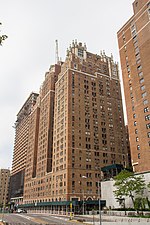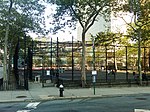Ralph Bunche Park
Headquarters of the United NationsParks in ManhattanPeace parksTurtle Bay, ManhattanUse mdy dates from November 2021

Ralph Bunche Park is a small municipal public park in the Turtle Bay neighborhood of New York City, on First Avenue between 42nd and 43rd Streets. It was named in 1979 for Ralph Bunche, the first African-American to win the Nobel Peace Prize.In 1985 the park was dedicated as the city's first Peace Park. As it covers less than a quarter of an acre (1,000 m²), it cannot accommodate major gatherings.
Excerpt from the Wikipedia article Ralph Bunche Park (License: CC BY-SA 3.0, Authors, Images).Ralph Bunche Park
1st Avenue, New York Manhattan
Geographical coordinates (GPS) Address Nearby Places Show on map
Geographical coordinates (GPS)
| Latitude | Longitude |
|---|---|
| N 40.749305555556 ° | E -73.969722222222 ° |
Address
1st Avenue 799
10017 New York, Manhattan
New York, United States
Open on Google Maps










